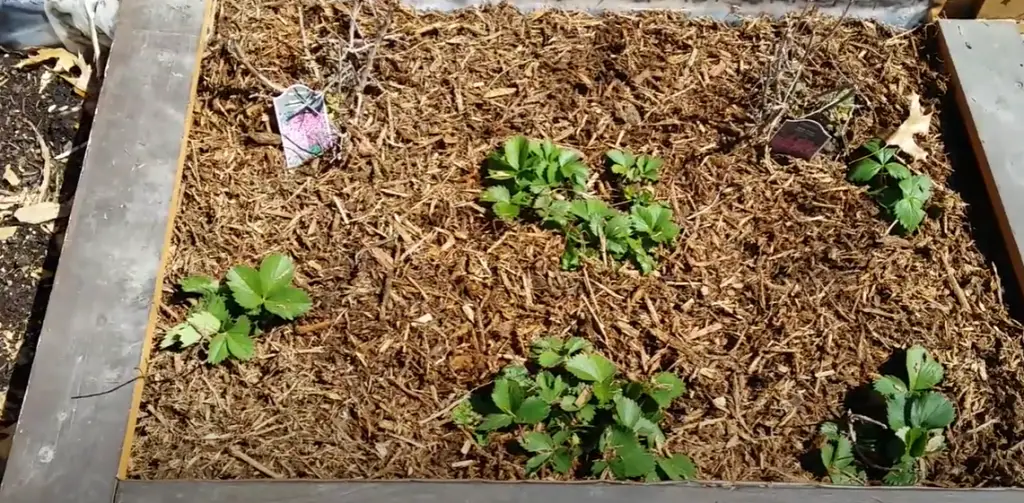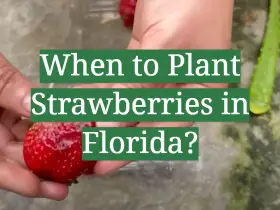Are you dreaming of biting into a sweet and juicy strawberry fresh from your own garden? With some patience, planning, and preparation, you could soon be picking your own homegrown strawberries in Pennsylvania. Knowing when to plant strawberries is the first step towards success, so if you’re living in Pennsylvania and looking to reap the rewards of growing tasty fruits at home then read on! In this blog post we’ll take a look at all the things that should influence when you plant your strawberries: timing for frost-free conditions, weather conditions such as soil temperature and moisture levels throughout the seasons, research on which variety will do best in PA climates – taking into account ripening dates – before guiding you through protecting those vulnerable young plants with mulch, covers or other protection methods. Let’s get started by exploring what makes fall planting so beneficial for Pennsylvanian gardeners.
What Are Different Varieties of Strawberries?
Strawberries have been around for centuries, and there are hundreds of varieties in existence. While not all of them are commercially available, each carries unique characteristics that make them stand out from the rest. [1]
Among the most popular varieties are Honeoye, Albion, Selva, Seascape, Seascape Fragaria vesca, Chandler, Allstar, and Camarosa. Each of these varieties has a unique flavor, texture, color, and ripening time.
Honeoye
Honeoye is a variety of strawberry that was developed in the 1970s. It has a crisp and sweet flavor, and is known for its high yields. In addition, it’s easy to grow and stores well which makes it one of the most popular varieties for commercial growers.

Albion
Albion strawberries are large, firm and sweet. They are considered to be one of the most flavorful varieties, making them an ideal choice for snacking or baking.
Selva
Selva strawberries have a sweet and soft flavor, with larger berries than other varieties. It is also known for its ability to produce large amounts of fruit in small spaces, which makes it a popular option for commercial growers.
Seascape
Seascape strawberries are sweet and firm, and are known for their high yields. They also have a long shelf life, making them an ideal choice for storing or shipping.
Seascape Fragaria vesca
This variety of strawberry is said to be the most flavorful of all. It has a high sugar content, and is great for baking or eating fresh.
Chandler
Chandler strawberries are known to be sweet and juicy, with a rich flavor that makes them perfect for snacking. They are also resistant to disease, making them an ideal choice for home gardeners.
Allstar
Allstar strawberries are a popular choice for jam and preserves due to their high yield and sweet flavor. They also have a long shelf life, making them an ideal choice for shipping or storing.
Camarosa
Camarosa strawberries are sweet and juicy, and have a bright red color. They also have a long shelf life, making them an excellent choice for shipping or storing. [2]

What Ways to Plant Strawberries?
There are a few different ways to plant and grow strawberries, depending on the space available for planting. Each has its own advantages and disadvantages.
- One way is to plant them in containers or hanging baskets. This works best for those who have limited garden space but still want to grow strawberries. The disadvantage of this type of planting is that it takes more maintenance to ensure the strawberries receive enough water and fertilizer.
- Planting in raised beds is another great way to grow strawberries, as it allows for better drainage and more control over the soil type. This is also ideal for those who need bigger plants with more space, since there’s plenty of room for them to spread out and take root. The drawback here is that it can be more expensive, because you’ll need to buy the materials for the raised beds.
- Finally, strawberry plants can also be planted directly in the ground. This is an easy option, as long as you have a spot with adequate sun and drainage. However, this method does require more vigilance against weeds and regular upkeep of the soil quality. [3]
Do Berries Grow Well in Pennsylvania?
Yes, berries grow very well in Pennsylvania. Strawberries, raspberries, blackberries, gooseberries, currants and blueberries all do well in the state’s cool climate. The key to success is to choose varieties that are suited to the local environment and soil type. Planting at the correct time of year will also help ensure a successful berry crop.
In addition to growing them in your own backyard, there are a number of pick-your-own farms in Pennsylvania offering an array of berry choices. Many offer not only the traditional varieties, but also some unusual types. By visiting these farms, you can sample many different kinds of berries and find out which ones are best for you.
If you’re looking to buy fresh berries in Pennsylvania, there are also farmers markets and farm stands throughout the state where you can purchase local produce. Being able to buy locally grown berries is an added bonus, as they have been grown without chemical fertilizers or pesticides and are often more flavorful than commercially-grown berries. [4]

When is the Best Time to Plant Strawberries in Pennsylvania?
The best time to plant strawberries in Pennsylvania is typically during the early spring. The optimal soil temperature for planting should be at least 45 degrees Fahrenheit or above. During this period, the plants will have enough energy to grow and establish a strong root system before cold temperatures arrive.
Home gardeners should also pay attention to the forecasted weather when deciding when to plant. If a cold snap is anticipated, you may want to wait until it passes or cover your plants with blankets and plastic sheets for additional protection.
In addition, the planting site should be chosen carefully. Strawberries prefer soil that is light and well-drained, so raised beds are ideal for providing good drainage during periods of heavy rainfall. The soil should also be enriched with organic matter, such as compost or aged manure.
Once the plants are in the ground, they should be monitored closely for signs of disease and pests. Hand-removing any weeds that may grow around the plants is often recommended. Additionally, applying a thick layer of mulch around each plant will reduce the need for frequent weeding and maintain soil moisture. [5]
How to Grow Strawberries?
Growing strawberries can be a rewarding experience. There are a few key steps to follow when growing strawberries.
Step 1: Choose the Right Variety
When selecting strawberry plants, it is important to choose a variety that is suited to your climate and soil conditions. If you are unsure which type of berry would work best for your area, speak to a local nursery or gardening center.
Step 2: Plant in the Right Location
Your strawberry patch should be planted in an area that gets plenty of sunlight throughout the day and is well-drained. Make sure to keep your patch away from any trees or shrubs which could shade it.
Step 3: Prepare the Soil
Strawberry plants prefer a loamy, slightly acidic soil with a pH between 5.5 and 6.8. When preparing the soil, be sure to mix in some organic matter and a fertilizer such as compost or manure for added nutrients.

Step 4: Plant the Strawberries
Once you have prepared the soil, it’s time to plant your strawberry plants. Plant each one individually, about 18 inches apart and 2-3 inches below the surface of the soil. Water them well after planting.
Step 5: Care for the Strawberry Plants
Strawberry plants need plenty of water and sunlight in order to thrive. Water them regularly, especially during dry periods, and make sure to feed them a balanced fertilizer every couple of weeks. Additionally, remove any dead or diseased leaves as soon as you notice them.
Step 6: Harvesting the Strawberries
Once your strawberry plants are ready to harvest, you can pick them one by one or use a tool to cut off the entire plant. Make sure to only pick those that are fully ripe and red in color. Enjoy! [6]
Secrets of Picking and Storing Strawberries
Strawberries are one of the most popular summer fruits, and picking them at the peak of ripeness is key to ensuring a tasty treat. Here are some tips for selecting and storing strawberries:
Picking Strawberries
- Look for bright red berries with shiny, firm skin. Darker spots on the skin indicate ripe or overripe fruit.
- Avoid white strawberries, as these are either unripe or have been harvested too early.
- Berries that are still attached to the vine are most likely fresher than those that have already been picked.
Storing Strawberries
- Do not wash your strawberries until you are ready to eat them.
- Place unwashed strawberries in the refrigerator, and eat them within a few days.
- Strawberries can also be stored in a sealed container or bag at room temperature for 1-2 days.
- If you have more strawberries than you can eat before they go bad, freeze them! Wash and hull the berries, then spread them out on a baking sheet until frozen. Once frozen, transfer them to a sealed container or bag and store in the freezer for up to 8 months.
Enjoying Strawberries
- When it comes time to enjoy your strawberries, don’t forget about the leaves! They are edible and contain healthy antioxidants that can be enjoyed alongside the berries.
- For an easy snack, dip fresh strawberries in a mixture of balsamic vinegar and sugar.
- Strawberries are also delicious when paired with yogurt, oatmeal, or smoothies.
- Add strawberries to your favorite baking recipes for added sweetness and nutrition! Try strawberry muffins, pies, cakes, or cobblers.
- For an easy summer dessert, top a bowl of fresh strawberries with a scoop of ice cream. Yum! [7]

What Diseases Can Strawberries Have and How to Fight Them?
The diseases that affect strawberries can be divided into three categories: fungal, bacterial, and viral.
Fungal Diseases
Fungal diseases are caused by different fungi species, including Alternaria alternata, Botrytis cinerea, and Ramularia collo-cygni. These can cause lesions on the leaves or fruit of a strawberry plant, leading to wilting or yellowing of foliage. To prevent and treat these diseases, good sanitation practices should be followed such as removing any debris or diseased plants from the area. Additionally, fungicides can be applied to strawberry plants as needed to prevent further spread of the fungus.
Bacterial Diseases
Bacterial diseases on strawberries are typically caused by Xanthomonas fragariae, which is a type of bacteria that can cause lesions on leaves and fruit. To combat these infections, it is important to remove any affected plants and debris from the area. Additionally, crop rotation and use of resistant varieties can help prevent future outbreaks.
Viral Diseases
Viral diseases on strawberry plants are generally caused by a virus called Strawberry Mild Mottle Virus (SMMV). Since there is no cure for viral diseases, the best way to prevent them is by controlling their spread. This can be done through crop rotation and by avoiding contact between diseased plants and healthy ones. Additionally, using resistant varieties of strawberries may also help reduce the chances of infection.
In general, it is important to practice good sanitation practices in order to keep your strawberry plants healthy. Maintaining a clean garden area, removing diseased plants, and using resistant varieties can all help to protect your plants from disease. Additionally, it is important to be mindful of how diseases spread in order to prevent future outbreaks. By following these practices you can ensure that your strawberries remain healthy and keep producing delicious fruit for many seasons! [8]
Is It Worth Fertilizing Strawberries?
Fertilizing strawberries is a great way to ensure that your plants stay healthy and produce a bountiful crop. Though there are many types of fertilizers available: liquid, granular, and organic. It is important to choose the right kind for your particular type of soil.
Organic fertilizers, such as compost or manure, are a great option for strawberry plants. They contain natural nutrients and are easier on the environment than chemical fertilizers. Additionally, they break down slowly over time, releasing their nutrients gradually into the soil. This helps promote strong root growth and encourages the development of healthy foliage.
For a long-term solution, granular fertilizers can be applied to the soil around your strawberry plants. These are also rich in nitrogen and have the advantage of being able to last up to several months before needing to be reapplied. This makes them ideal for gardeners who want a steady supply of nutrients without having to constantly fertilize their strawberry plants.
Overall, fertilizing strawberries is an important part of keeping them healthy and productive. Whether you choose organic, liquid, or granular fertilizers, be sure to read the instructions carefully before applying them to your plants. With a little bit of effort, you can ensure that your strawberry plants stay healthy and produce plenty of delicious fruits! [9]
FAQs
What month is best to plant strawberries?
The best time to plant strawberries is typically in late winter or early spring, depending on the climate. It’s important to make sure that the ground has had sufficient time to warm up before planting, so that the plants will have a good start once they are put into the soil. Planting too late can lead to lower yields and an earlier end of season. As always, be sure to check with your local gardening experts for the best advice on when to plant in your specific area.
Can you plant strawberries in the fall in PA?
Yes. Planting strawberry plants during the fall season allows them to become established and gives them time to produce a stronger root system before winter. The ideal planting time for strawberries is late August through mid-September when soil temperatures reach 60°F or higher. If planted early enough, your strawberry plants should be blooming and bearing fruit in the spring. Before planting, make sure to test your soil and add any amendments needed for the best possible outcome.
Can strawberries survive winter?
Strawberries are one of the most popular fruits and are grown in many areas across the United States. But can they survive a cold winter? While some strawberry plants may be able to withstand colder temperatures, most varieties will die if exposed to freezing conditions for too long.
To protect your strawberry plants from frost damage, you should cover them with a layer of mulch or straw. This will help insulate the soil and protect the roots from the cold. Additionally, you can use a frost blanket to provide extra warmth for your plants during particularly chilly nights.
You also need to water your strawberry plants regularly throughout the winter months so that they remain hydrated and healthy. Make sure not to overwater them though, as this can cause the soil to become waterlogged and increase the risk of root rot.
Where do strawberries grow best?
Strawberries are one of the most popular berries, and they can be found growing in many places around the world. The ideal environment for strawberries is an area with plenty of sunshine and moist soil. Strawberries need at least six hours of direct sunlight a day to thrive, so they are best grown in warm climates. They will also grow well in cooler areas if they have plenty of protection from frost and wind.
Strawberries also need well-drained soil with plenty of organic matter to ensure their roots can get enough nutrients. Sandy loam soils are perfect for strawberries, as they provide good drainage and nutrient retention. The pH level of the soil should be between 5.5 and 6.2 so that the plants
Useful Video: Everbearing Strawberries zone 6 South Central Pennsylvania
Final Thoughts
Planting strawberries in Pennsylvania can be an exciting experience. It is important to plan ahead and find out the best times for planting and harvesting the best crop. Strawberries may be planted earlier than other fruits, as early as late January, or during the period from mid-March through April. This will depend on your location, weather pattern, and soil conditions. And research indicates that adequately prepared soil with sufficient nutrients is essential for successful growing of berries. In addition, they require a good amount of light because strawberry plants are shallow-rooted and need light to reach their roots. The best way to ensure success is by planning ahead and understanding the environment in which you plant your strawberries. With just a bit of extra effort you can look forward to a scrumptious harvest!
References:
- https://www.gardeningknowhow.com/edible/fruits/strawberry/strawberry-plant-types.htm
- https://strawberryplants.org/strawberry-varieties/
- https://www.gardenersworld.com/how-to/grow-plants/how-to-grow-strawberries/
- https://www.tnnursery.net/blogs/news/the-top-berry-plants-for-pennsylvania-a-comprehensive-guide
- https://extension.psu.edu/growing-strawberries
- https://www.rhs.org.uk/fruit/strawberries/grow-your-own
- https://www.realsimple.com/food-recipes/shopping-storing/food/how-to-store-strawberries
- https://extension.colostate.edu/topic-areas/yard-garden/strawberry-diseases-2-931/
- https://theeducatorsspinonit.com/growing-strawberries-is-it-worth-it/










Leave a Reply
View Comments